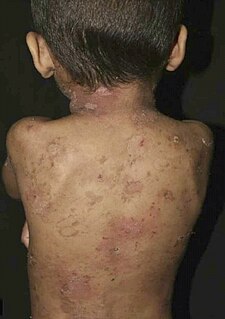Related Research Articles

Epidermolytic ichthyosis (EI), also known as bullous epidermis ichthyosis (BEI), epidermolytic hyperkeratosis (EHK), bullous congenital ichthyosiform erythroderma (BCIE), bullous ichthyosiform erythroderma or bullous congenital ichthyosiform erythroderma Brocq, is a rare and severe form of ichthyosis this skin disease affects around 1 in 300,000 people.

Hypertrichosis is an abnormal amount of hair growth over the body. The two distinct types of hypertrichosis are generalized hypertrichosis, which occurs over the entire body, and localized hypertrichosis, which is restricted to a certain area. Hypertrichosis can be either congenital or acquired later in life. The excess growth of hair occurs in areas of the skin with the exception of androgen-dependent hair of the pubic area, face, and axillary regions.

Palmoplantar keratodermas are a heterogeneous group of disorders characterized by abnormal thickening of the palms and soles.

Nevoid basal-cell carcinoma syndrome (NBCCS), is an inherited medical condition involving defects within multiple body systems such as the skin, nervous system, eyes, endocrine system, and bones. People with this syndrome are particularly prone to developing a common and usually non-life-threatening form of non-melanoma skin cancer. About 10% of people with the condition do not develop basal-cell carcinomas (BCCs).
Juvenile plantar dermatosis is a condition usually seen in children between the ages of 3 and 14, and involves the cracking and peeling of weight bearing areas of the soles of the feet. One of the earliest descriptions was made by British dermatologist Darrell Wilkinson.
Ichthyosis hystrix is a group of rare skin disorders in the ichthyosis family of skin disorders characterized by massive hyperkeratosis with an appearance like spiny scales. This term is also used to refer to a type of epidermal nevi with extensive bilateral distribution.

Acrokeratoelastoidosis of Costa is a familial condition characterized by multiple keratotic papules on the dorsum of the hands and feet, palms, soles, in which electron microscopy shows rarified, abnormal elastic tissue.

Tyrosinemia type II is an autosomal recessive condition with onset between ages 2 and 4 years, when painful circumscribed calluses develop on the pressure points of the palm of the hand and sole of the foot.

Corneodermatosseous syndrome is an autosomal dominant condition with onset in infancy, characterized by corneal dystrophy, photophobia, diffuse palmoplantar keratoderma, distal onycholysis, skeletal abnormalities, with brachydactyly, short stature, and medullary narrowing of digits.

Porokeratosis is a specific disorder of keratinization that is characterized histologically by the presence of a cornoid lamella, a thin column of closely stacked, parakeratotic cells extending through the stratum corneum with a thin or absent granular layer.
Pustular bacterid is a skin condition characterized by a symmetric, grouped, vesicular or pustular eruption on the palms and soles marked by exacerbations and remissions over long periods of time.
Keratoderma climactericum is a skin condition characterized by hyperkeratosis of the palms and soles beginning at about the time of menopause.
Black heel and palm is a skin condition characterized by a sudden shower of minute, black, punctate macules occurring most often on the posterior edge of the plantar surface of one or both heels.
Howel–Evans syndrome is an extremely rare condition involving thickening of the skin in the palms of the hands and the soles of the feet (hyperkeratosis). This familial disease is associated with a high lifetime risk of esophageal cancer. For this reason, it is sometimes known as tylosis with oesophageal cancer (TOC).

An acral nevus is a cutaneous condition characterized by a skin lesion that is usually macular or only slightly elevated, and may display uniform brown or dark brown color, but often with linear striations.
Verrucae palmares et plantares is a cutaneous condition characterized by warts on the palms and soles.
Tripe palms, is a cutaneous condition characterized by ridged velvety lesions on the palms resembling the lining of a cow's stomach (tripe).
Haim–Munk syndrome is a cutaneous condition caused, like Papillon-Lefevre Syndrome, by a mutation in the cathepsin C gene. It is named after Dr. Salim Haim and Dr. J Munk, who first described the disease in 1965.
Hyperprolactinemic SAHA syndrome is a cutaneous condition characterized by lateral hairiness, oligomenorrhea, and sometimes acne, seborrhea, FAGA I, and even galactorrhea.
Hypertrichosis simplex of the scalp is a cutaneous condition caused by defects in the corneodesmosin protein.
References
- ↑ Rapini, Ronald P.; Bolognia, Jean L.; Jorizzo, Joseph L. (2007). Dermatology: 2-Volume Set. St. Louis: Mosby. ISBN 978-1-4160-2999-1.
| This dermatology article is a stub. You can help Wikipedia by expanding it. |